We've just passed into 2015, but rumors about next year’s iPhone are already surfacing online. One of them brings us a pretty interesting view of the future.
Intel has been struggling to find ways to weasel itself into iPhone production, but so far its attempts have been going nowhere.
Still, Intel is a big part of Apple’s Mac range of products. Actually, this very week, the Cupertino tech giant unveiled a brand new MacBook, as well as refreshed MacBook Pro and MacBook Air models taking advantage of the chip maker’s 5th generation Broadwell architecture, which focuses on prolonged battery life rather than performance.
Intel LTE architecture coming to the iPhones of 2016
According to sources familiar with the matter that talked to Venture Beat, the next-generation iPhone models that will be released in 2016 will make use of Intel’s new XMM 7360 LTE modem.
Intel’s first wireless modem made its debut earlier this month at MWC 2015 and will be adopted by Apple, who is attempting to diversify its baseband chip suppliers.
The Cupertino tech giant will be using the Intel modems inside a special iPhone variant that will be sold in markets like Asia and Latin America.
It appears Apple engineers have been traveling to Munich, Germany, where the chip giant has set up its development offices and works on the LTE chips. Intel purchased the facility after it acquired Infineon for $1.4 / €1.3 billion back in 2010.
The thing is, prior to Intel’s acquisition, Apple had been using Infineon chipsets for its iPhones ever since the first handset came out back in 2007.
After Intel stepped into the picture, Apple had to switch to Qualcomm to get its wireless chips. However, sources familiar with the matter say Apple and Qualcomm don’t really have a smooth working relation.
Intel XMM 7360 technical specifications
The XMM 7360 chip includes LTE-FDD/TDD up to 450 Mbps, LTE Advanced up to Category 10, Voice over LTE, 3X carrier aggregation, and the usual compatibility with worldwide band support. Most importantly, the chip is compatible with TD-SCDMA, a singular wireless standard which is used by China Mobile.
Getting to be a part of an iconic device such as the iPhone is a major step forward for Intel, who already acknowledged being behind Qualcomm in the smartphone market. But times are shifty in the mobile market.

 14 DAY TRIAL //
14 DAY TRIAL //